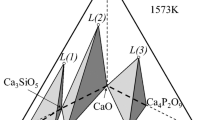Abstract
This study aims to solve the problems related to the kiln method in which the slag phase melts at high temperature and the phosphorus reduction rate is reduced at low temperature. This study also intends to determine whether the carbothermal reduction reaction of phosphate rock would be catalyzed using coke-supported NiSO4. The reaction conditions were optimized at 1300 °C and 60 min, and the results were as follows: SiO2–CaO mass ratio, 1.1; optimum coke excess coefficient, 1.1; and NiSO4 support, 5% of the coke mass. When the reaction time was extended to 4 h, the reduction rate of the coke-supported NiSO4 system increased from 75.56% to 90.68%, an increase of 15.12%. Scanning electron microscopy analysis of the reaction slag indicated that with coke-supported NiSO4 at 1300 °C, the slag phase exhibited no morphological change. Kinetic analysis indicated that the reaction order was not changed by the coke-supported NiSO4 and remained in accordance with the first-order reaction law, and the activation energy decreased by 29.1 kJ/mol from 255.65 kJ/mol to 226.55 kJ/mol, compared with the unsupported system. XRD analysis of the reaction slag indicated that the reflection of the material was significantly reduced; however, no new substances was formed with coke-supported NiSO4, which suggested that NiSO4 only acted as a catalyst and caused no change in the reaction process.
Similar content being viewed by others
References
Rashid MM, Jahan M, Islam KS (2016) Impact of nitrogen, phosphorus and potassium on Brown plant hopper and tolerance of its host rice plants. Rice Sci 23:119–131
Cao RF, Xia JP, Li WL, Han YW (2018) Effects of alkali metal carbonates on carbothermal reduction of phosphate rock. J Chem Eng Chin Univ 32:568–576
Geng RX, Xia JP, Chen ZJ, Yang J, Zheng S, Liu HL (2016) Effects of potassium feldspar on slagging and fluxing in phosphorus produced via electric furnace. Phosphorus Sulfur Silicon Relat Elem 192:475–480
Regina K, Zygmunt K, Danuta PK, Zbigniew W, Katarzyna G (2008) Tripolyphosphate made from wet-process phosphoric acid with the use of a rotary kiln. Ind Eng Chem Res 47:6821–6827
Wang XJ, Tang L, Jiang Z (2014) Numerical simulation of venturi ejector reactor in yellow phosphorus purification system. Nucl Eng Des 268:18–23
Li Y, Chen ZJ, Yang J, Xia JP (2018) Study of the silica or K-feldspar as fluxing agent for the yellow phosphorus production. Phosphorus Sulfur Silicon Relat Elem 193:520–527
Liu ML (2009) Study of producing industrial phosphoric acid with middle-low grade phosphate rock by vertical kiln method. Chem Res Appl 21:131–134
Deng SY, Liang B, Li C, Wu P, Qiu LY, Wang LM (2012) Research progress of kiln phosphoric acid process. Chem Ind Eng Prog 31:402–406
Lu L, Liang B, Liu Q, Liu WZ, Yang HH, Wu P, Li C (2016) Reactions between P2O5 and calcium phosphate in kiln phosphoric acid. J Chem Ind Eng 67:4399–4405
Megy JA Rotary kiln process for phosphoric acid manufacture: US2005019598. 2005-06-03
Jacob KD, Reynolds DS, Hill WL (2002) Reduction of tricalcium phosphate by carbon. Ind Eng Chem 20:1204–1210
Jacob MU, Frederic L, Won CP, Robert AH, Joseph M, Howard R (1986) Reduction of phosphate ores by carbon: part I. Process variables for design of rotary kiln system. Metall Trans B 17:861–868
Yang L, Yan Y, Hu ZH (2013) Reduction of low and medium-grade phosphorite with high—calcium proportion. Mod Chem Ind 33:68–72
Lin ZF, Hu B, Zhou XL (2017) Research Progress of Ni- based catalysts. J Chem Ind Eng 68:26–36
Yang ZY, Gong L, Ran P (2012) Preparation of nitric humic acid by catalytic oxidation from Guizhou coal with catalysts. J China Univ Min Technol 22:246–250
Othman NF, Bosrooh MH (2016) Catalytic Adaro coal gasification using dolomite and nickel as catalyst. Procedia Eng 148:308–313
Huang GB, Wang ZQ, Li QF, Huang JJ (2014) Syngas methanation over nickel catalyst in liquid-phase. J Fuel Chem Technol 42:952–957
Ding Z, Zhao XZ, Shaw LL (2015) Reaction between LiBH4 and MgH2 induced by high-energy ball milling. J Power Sources 293:236–245
Ding Z, Ma WH, Wei KX, Wu JJ, Zhou Y, Xie KQ (2012) Boron removal from metallurgical-grade silicon using lithium containing slag. J Non-Cryst Solids 358:2708–2712
Qiu LY, Liang B, Jiang LK (1996) Investigation on the solid state reduction of fluorapatite. J Chem Ind Eng 47:65–71
Liu YC, Li QX, Qiu ZZ, Liu YC (2013) Mechanisms SiO2 on the fluoraptite by carbothermic reduction reaction in vacuum. Chin J Vac Sci Technol 33:293–296
Liu YC, Li QX, Liu YC (2012) Carbothermal reduction mechanism of fluorapatite in vacuum. Vacuum 49:84–87
Yin XG (2014) Progress of industrialization technology for kiln process phosphoric acid in China. Phosphate Compd Fert 29:37–40
Li Y, Chen ZJ, Geng RX, Xia JP (2018) Studies on extraction of phosphorus from phosphate ore by electric furnace with different fluxingagents. Phosphorus Sulfur Silicon Relat Elem 193:141–148
Sohn JR, Lee SH (2007) Effect of TiO2-ZrO2 composition on catalytic activity of supported NiSO4 for ethlene dimerization. Appl Catal A 321:27–34
Li Q, Hu B, Wu YX (2014) Process parameters and kinetics of smelting reduction technology for low-phosphate ore reduction. J Chem Eng Chin Univ 28:905–910
Yang J, Chen JJ, Liu HY (2015) Enhanced effect of aluminum impurity on solid state carbothermal reduction of fluorapatite. J Sichuan Univ Eng Sci Ed 47:186–191
Li Q, Hu B, Wu YX (2013) Reaction kinetics of phosphate ore with carbon by smelting reduction technology. Chem Eng 41:53–56
Jiang LK, Qiu LY, Liang B (1995) Solid reaction mechanism for the thermal reduction of fluorapatite by carbon. J Chengdu Univ Sci Technol 1:1–5
Li Y, Xia JP, Liu HL, Cao RF (2017) Mechanism of silica and K-feldspar as flux agents in phosphate ore carbothermal reduction. J Chem Eng Chin Univ 31:1120–1126
Acknowledgments
The authors thank the National Natural Science Foundation of China (No. 21566018).
Author information
Authors and Affiliations
Corresponding authors
Rights and permissions
About this article
Cite this article
Cao, R., Li, Y., Xia, J. et al. NiSO4 as Additive Effect on the Carbothermal Reduction Process of Phosphate Rock and SiO2. Silicon 11, 2829–2836 (2019). https://doi.org/10.1007/s12633-019-0071-x
Received:
Accepted:
Published:
Issue Date:
DOI: https://doi.org/10.1007/s12633-019-0071-x




